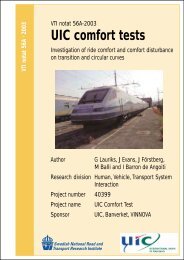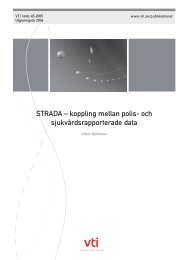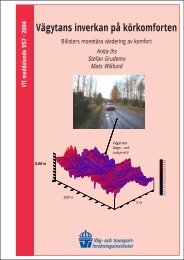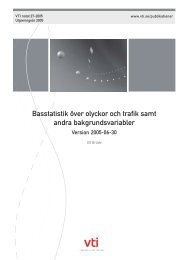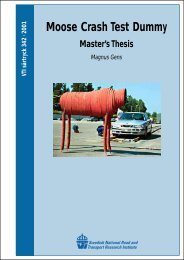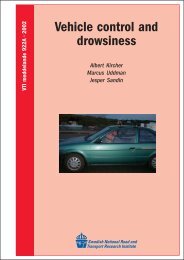Missing text /vti/pages/publication/downloadpdf for sv
Missing text /vti/pages/publication/downloadpdf for sv
Missing text /vti/pages/publication/downloadpdf for sv
You also want an ePaper? Increase the reach of your titles
YUMPU automatically turns print PDFs into web optimized ePapers that Google loves.
GPS controlled salt spreading. Trial on a test track<br />
by Staffan Möller<br />
VTI (Swedish National Road and Transport Research Institute)<br />
SE-581 95 Linköping, Sweden<br />
Summary<br />
Background<br />
The purpose of the project is to test and document GPS controlled salt spreading on a<br />
test track by weighing distributed salt quantities and compare with intended amounts of<br />
salt at different spreading amounts, spreading widths, symmetries, speeds and types of<br />
salt (pre wetted salt and brine).<br />
The test is to study how salt distribution is affected by changes in the road section both<br />
to the right and to the left of the through lane or the two through lanes. Such changes<br />
should imitate <strong>for</strong> example transition from one lane to two lanes or from two lanes to<br />
one lane on a 2 + 1 road or passing a refuge or a bus-bay. A test track was marked with<br />
silver tape.<br />
In order to measure the distributed salt quantities plastic sheets, with the size 1.1 x 1.6<br />
metre, were taped on the surfacing. Centered over the plastic sheets cloths of curtain<br />
fabric, with the size 1.0 x 1.5 metre, were placed. The cloths were held in place by<br />
chains.<br />
With an ideal GPS control, settings of spreading width and symmetry can change<br />
continuously, so that the salt is distributed adjusted to varying section widths. Today,<br />
technological developments, however, have only reached as far as settings can be done<br />
step by step.<br />
In this project, we have chosen to study how close to the ideal salt spreading today's<br />
technology can get.<br />
Results<br />
When a comparison is made between the salt distribution with and without GPS control<br />
of the salt spreader the following results were found.<br />
Using pre wetted salt on two lanes and a bus-bay the results with GPS control got better,<br />
that means gave better correspondence with the intended amounts of salt, on the right lane<br />
compared with no change of the salt spreader. On the left lane the results were about the<br />
same. Both with and without GPS control small amounts of salt ended up on the bus-bay.<br />
Using brine on two lanes and a bus-bay the results on the right and left lane respectively<br />
were about the same with and without GPS. On the bus-bay the results with GPS got worse<br />
compared with no change of the salt spreader.<br />
Using pre wetted salt on a transition from two lanes to one the results with GPS control got<br />
worse on the right lane compared with no change of the salt spreader. On the left lane GPS<br />
control resulted in higher amounts of salt, but not better results, compared with without<br />
GPS.<br />
VTI rapport 791 7



